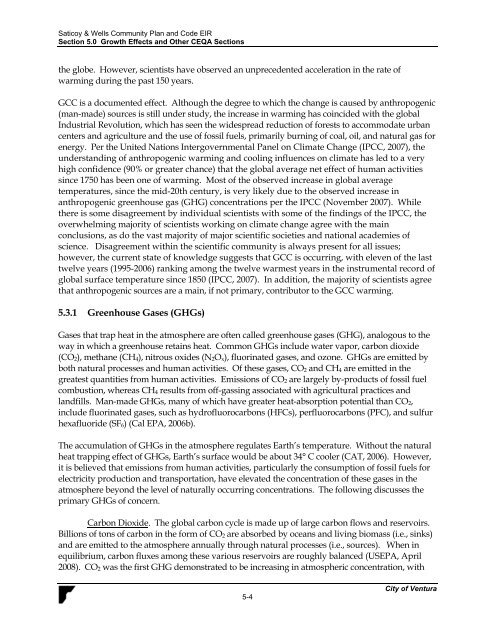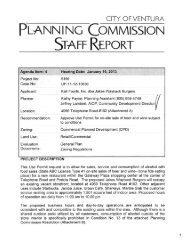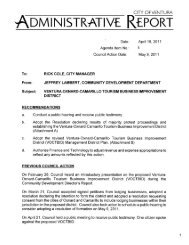Saticoy & Wells Community Plan & Development ... - City Of Ventura
Saticoy & Wells Community Plan & Development ... - City Of Ventura
Saticoy & Wells Community Plan & Development ... - City Of Ventura
You also want an ePaper? Increase the reach of your titles
YUMPU automatically turns print PDFs into web optimized ePapers that Google loves.
<strong>Saticoy</strong> & <strong>Wells</strong> <strong>Community</strong> <strong>Plan</strong> and Code EIRSection 5.0 Growth Effects and Other CEQA Sectionsthe globe. However, scientists have observed an unprecedented acceleration in the rate ofwarming during the past 150 years.GCC is a documented effect. Although the degree to which the change is caused by anthropogenic(man-made) sources is still under study, the increase in warming has coincided with the globalIndustrial Revolution, which has seen the widespread reduction of forests to accommodate urbancenters and agriculture and the use of fossil fuels, primarily burning of coal, oil, and natural gas forenergy. Per the United Nations Intergovernmental Panel on Climate Change (IPCC, 2007), theunderstanding of anthropogenic warming and cooling influences on climate has led to a veryhigh confidence (90% or greater chance) that the global average net effect of human activitiessince 1750 has been one of warming. Most of the observed increase in global averagetemperatures, since the mid-20th century, is very likely due to the observed increase inanthropogenic greenhouse gas (GHG) concentrations per the IPCC (November 2007). Whilethere is some disagreement by individual scientists with some of the findings of the IPCC, theoverwhelming majority of scientists working on climate change agree with the mainconclusions, as do the vast majority of major scientific societies and national academies ofscience. Disagreement within the scientific community is always present for all issues;however, the current state of knowledge suggests that GCC is occurring, with eleven of the lasttwelve years (1995-2006) ranking among the twelve warmest years in the instrumental record ofglobal surface temperature since 1850 (IPCC, 2007). In addition, the majority of scientists agreethat anthropogenic sources are a main, if not primary, contributor to the GCC warming.5.3.1 Greenhouse Gases (GHGs)Gases that trap heat in the atmosphere are often called greenhouse gases (GHG), analogous to theway in which a greenhouse retains heat. Common GHGs include water vapor, carbon dioxide(CO 2 ), methane (CH 4 ), nitrous oxides (N 2 O x ), fluorinated gases, and ozone. GHGs are emitted byboth natural processes and human activities. <strong>Of</strong> these gases, CO 2 and CH 4 are emitted in thegreatest quantities from human activities. Emissions of CO 2 are largely by-products of fossil fuelcombustion, whereas CH 4 results from off-gassing associated with agricultural practices andlandfills. Man-made GHGs, many of which have greater heat-absorption potential than CO 2 ,include fluorinated gases, such as hydrofluorocarbons (HFCs), perfluorocarbons (PFC), and sulfurhexafluoride (SF 6 ) (Cal EPA, 2006b).The accumulation of GHGs in the atmosphere regulates Earth’s temperature. Without the naturalheat trapping effect of GHGs, Earth’s surface would be about 34° C cooler (CAT, 2006). However,it is believed that emissions from human activities, particularly the consumption of fossil fuels forelectricity production and transportation, have elevated the concentration of these gases in theatmosphere beyond the level of naturally occurring concentrations. The following discusses theprimary GHGs of concern.Carbon Dioxide. The global carbon cycle is made up of large carbon flows and reservoirs.Billions of tons of carbon in the form of CO 2 are absorbed by oceans and living biomass (i.e., sinks)and are emitted to the atmosphere annually through natural processes (i.e., sources). When inequilibrium, carbon fluxes among these various reservoirs are roughly balanced (USEPA, April2008). CO 2 was the first GHG demonstrated to be increasing in atmospheric concentration, with5-4<strong>City</strong> of <strong>Ventura</strong>
















